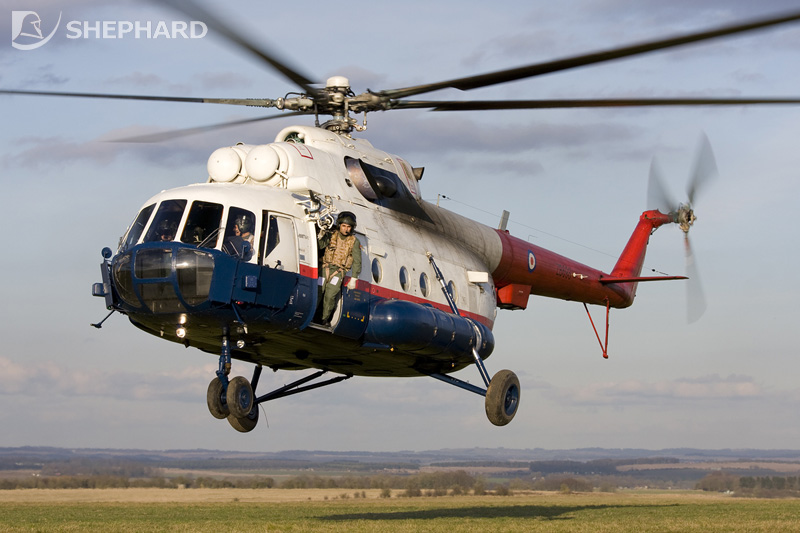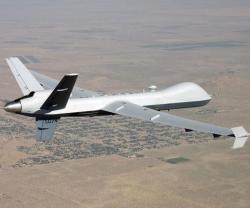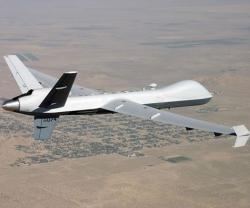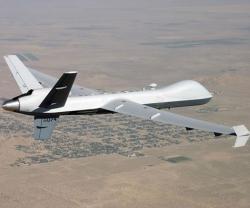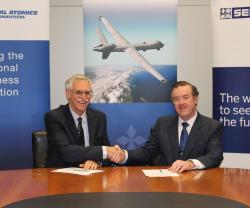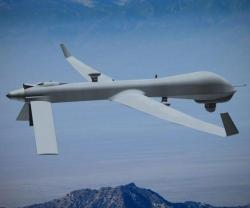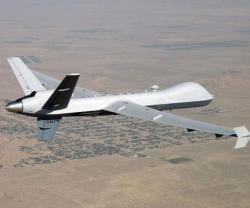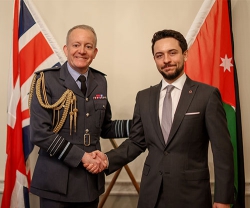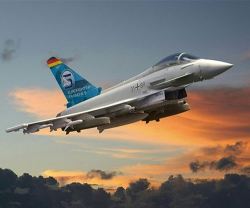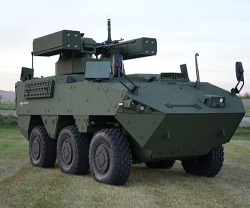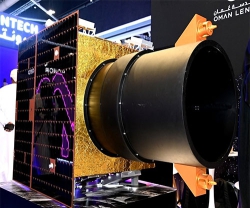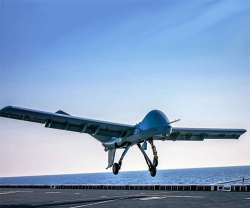Nen Lynx AMR flown on a predator B UAS
24.05.2010 North America
General Atomics Aeronautical Systems, Inc. (GAASI), a leading manufacturer of Unmanned Aircraft Systems (UAS), tactical reconnaissance radars, and surveillance systems, announced that it has successfully completed a set of flight tests of its next generation Synthetic Aperture Radar/Ground Moving Target Indicator (SAR/GMTI) radar, the Lynx® Advanced Multi-channel Radar (AMR), on the company’s capital Predator® B UAS. The flights were completed on May 7 at GA-ASI’s Gray Butte Flight Operations Facility in Palmdale, Calif., following software testing and aircraft payload integration.
“This first flight of the Lynx AMR on Predator B marks the first time that radar dismount detection capability has been demonstrated on a Predator-class aircraft,” said Linden Blue, President, Reconnaissance Systems Group, General Atomics Aeronautical Systems, Inc. “This critical milestone demonstrates the ‘plug-and-play’ attributes of the Lynx QRC [Quick Reaction Capability] AMR and is the last major objective we needed to achieve before offering this capability to various customers by the end of 2010.”
During the AMR flight tests, the radar was specifically evaluated for dismount (personnel walking or running) detection performance over its full field-of-regard. Lynx AMR achieves unmatched dismount detection performance using Space Time Adaptive Processing (STAP) and delivers compliant STANAG 4607 output to the Ground Control Station (GCS) and its dissemination channels. The GCS software also supports real-time cross-cueing to the aircraft’s Electro-Optical Infrared (EO/IR) payload.
The flight test campaign included evaluation of the currently operational Lynx SAR in nose-on geometry at Predator B loitering speeds. Using a typical route surveillance ‘push broom’ flight profile, Lynx was able to detect slow walking people without modifications to the currently operational software. This effectiveness was verified through several instrumented tests to characterize the performance envelope.
“The ability to detect and track dismounts and slow moving vehicles over large areas and to cross-cue the on-board video sensor to areas of interest is an emerging military and civilian surveillance requirement, added Blue. “The Lynx AMR provides this capability over its full field-of-regard in a low-cost, ‘plug-and-play’ configuration for Predator B and Sky Warrior® Alpha aircraft.”
GA-ASI initially demonstrated a low-cost dismount detection capable Lynx radar in early 2009 on the Dual Beam Development Program on manned aircraft flight tests. Since then, a series of software modifications and additional flight tests have been conducted on manned aircraft to improve and transition this capability from an engineering demonstration to a QRC configuration. These flight tests have demonstrated the ability to detect dismounts over the full field-of-regard and provide accurate cross-range position estimates for cross-cueing the EO/IR sensor in its narrow field-of-view. As a follow-on to this testing activity, the software-only development will continue through the end of the year to optimize the dismount detection performance.
“This first flight of the Lynx AMR on Predator B marks the first time that radar dismount detection capability has been demonstrated on a Predator-class aircraft,” said Linden Blue, President, Reconnaissance Systems Group, General Atomics Aeronautical Systems, Inc. “This critical milestone demonstrates the ‘plug-and-play’ attributes of the Lynx QRC [Quick Reaction Capability] AMR and is the last major objective we needed to achieve before offering this capability to various customers by the end of 2010.”
During the AMR flight tests, the radar was specifically evaluated for dismount (personnel walking or running) detection performance over its full field-of-regard. Lynx AMR achieves unmatched dismount detection performance using Space Time Adaptive Processing (STAP) and delivers compliant STANAG 4607 output to the Ground Control Station (GCS) and its dissemination channels. The GCS software also supports real-time cross-cueing to the aircraft’s Electro-Optical Infrared (EO/IR) payload.
The flight test campaign included evaluation of the currently operational Lynx SAR in nose-on geometry at Predator B loitering speeds. Using a typical route surveillance ‘push broom’ flight profile, Lynx was able to detect slow walking people without modifications to the currently operational software. This effectiveness was verified through several instrumented tests to characterize the performance envelope.
“The ability to detect and track dismounts and slow moving vehicles over large areas and to cross-cue the on-board video sensor to areas of interest is an emerging military and civilian surveillance requirement, added Blue. “The Lynx AMR provides this capability over its full field-of-regard in a low-cost, ‘plug-and-play’ configuration for Predator B and Sky Warrior® Alpha aircraft.”
GA-ASI initially demonstrated a low-cost dismount detection capable Lynx radar in early 2009 on the Dual Beam Development Program on manned aircraft flight tests. Since then, a series of software modifications and additional flight tests have been conducted on manned aircraft to improve and transition this capability from an engineering demonstration to a QRC configuration. These flight tests have demonstrated the ability to detect dismounts over the full field-of-regard and provide accurate cross-range position estimates for cross-cueing the EO/IR sensor in its narrow field-of-view. As a follow-on to this testing activity, the software-only development will continue through the end of the year to optimize the dismount detection performance.
Previous PostHarris To Acquire CapRock Communications
Latest news
Latest events
Dubai International Air Chiefs’ Conference (DIACC 2025)
16 Nov 2025Atlantis, The Palm Dubai - United Arab EmiratesDubai Airshow
17 - 21 Nov 2025Dubai World Central (DWC) - United Arab EmiratesEgypt Defence Expo (EDEX)
01 - 04 Dec 2025Egypt International Exhibition Center New Cairo - EgyptDoha International Maritime Defence Exhibition & Conference (DIMDEX 2026)
19 - 22 Jan 2026Doha - Qatar

